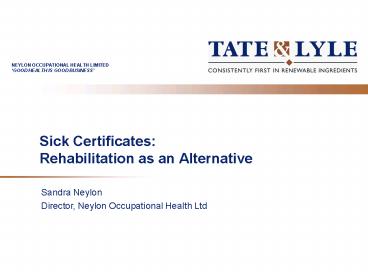Sick Certificates: Rehabilitation as an Alternative - PowerPoint PPT Presentation
1 / 13
Title:
Sick Certificates: Rehabilitation as an Alternative
Description:
10% of Kent police officers are off sick more than 28 days/annum! ( Personnel Today Feb 08) Average sick absence rates 7.8 days for London. Since 2002 Tate & Lyle ... – PowerPoint PPT presentation
Number of Views:37
Avg rating:3.0/5.0
Title: Sick Certificates: Rehabilitation as an Alternative
1
Sick Certificates Rehabilitation as an
Alternative
Sandra Neylon Director, Neylon Occupational
Health Ltd
2
Introduction
- Statistics
- What is a sick certificate?
- Rehabilitation
- Case management
- Keys to success
- Summary
3
The Statistics
- Sickness absence costs UK businesses 12.2
billion/year! (CBI 2007) - 10 of Kent police officers are off sick more
than 28 days/annum! (Personnel Today Feb 08) - Average sick absence rates 7.8 days for London
- Since 2002 Tate Lyle
- has reduced long-term sickness/absence by 60
- reduced ill-health early retirement by 75
- and overall sickness/absence is currently running
at 2.2
4
Work is Good for Your Health
- Best way out of poverty
- Positive health and social consequences
- Being out of work
- One of the biggest Public Health challenges
facing Western Society - 80 of people unemployed for 6 months or more
will never return to work
5
Work is Good for Your Health
- If you are out of work for more than six-months,
your chances of committing suicide are - 40 times higher than if you are working. Being
- out of work is more dangerous to your health than
smoking 60 cigarettes a day! - (Unum Centre for Psychological and Disability
Research)
6
What is a Sick Certificate?
- Historical context Medical model justifying
incapacity GP used to be responsible for
government expenditure on sickness. Now employer
is responsible for funding sickness/absence - Now have system of sick cert on demand -
Research proves that GPs are despondent with the
system as it generates a vast majority of
consultations - Very rare that GPs have OH experience
- Issued by a GP or hospital for sick payment
purposes only - An advisory note based on fitness for full role
7
What is the Alternative?
Rehabilitation - A program of clinical and
occupational services with the aim of returning
employees to their contractual role or finding a
suitable alternative role if possible. tempora
ry changes in duties, hours or expectations of an
employees job until the employee is fit to resume
normal duties. (Van Duijin et al 2004)
8
Early Intervention is Key
- The sooner action is taken, the better the
chances are of an employee making a full and
speedy return to work - Once an employee has been off sick for more than
six weeks, the problem is often compounded and
the chances of returning to work at all are
significantly reduced - Work in a well-managed workplace is a treatment
for people recovering from sickness absence and
an early return to work improves both mental and
physical recovery - Simple adjustments can enable workers to return
to work safely before their symptoms completely
disappear - Workers can normally return before they are 100
fit(HSE Managing sickness absence and return to
work 2006)
9
Case Management
- Proactive rehabilitation programme agreed with
employee - Round Table Approach - By working with the
employee, the manager, the GP/Consultant (if
necessary) and the human resources team, a care
pathway can be mapped out by Occupational Health
to ensure that employees are returned to health,
work and efficiency at the earliest date - Reduced hours amended shifts reduced or
alternative duties transportation - Letters to GPs and Consultants
10
Keys to Success
- Requires a robust sickness/absence policy and
strong commitment from employees and managers - Rehabilitation must be an integral part of every
sickness/absence policy - Employee education about sickness, sick
certificates and rehabilitation effective
communication is a must!
11
Summary
- In conclusion
- Rehabilitation is integral to creating good
health at work - It expedites employee recovery from illness or
injury - For rehabilitation to be successful there is a
need for increased awareness and commitment among
employees, managers and unions or employee
representatives - Good communication links with GPs and
Consultants are also vital - It is associated with high performing and well
managed organisations
12
- Questions?
13
Thank you for your time ..































